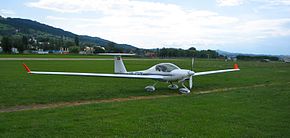Motor sailer
According to the regulations of the European Union , motor gliders (also motor gliders ) are aircraft that are equipped with one or more engines and have the characteristics of a glider when the engines are switched off. This means that the alternate operating modes powered flight and glider flight are possible with these aircraft . In Germany, Austria and Switzerland they represent their own aircraft class . Corresponding machines have aircraft registration numbers that begin with DK…, OE-9… or HB-2….
Motor gliders can be divided into touring motor gliders and gliders with auxiliary engines . There are also ultra-light motor gliders, which are considered ultra-light aircraft in Germany and belong to the aircraft class of air sports equipment . The engine is powered by piston engines (e.g. from Limbach , Sauer, Stihl, Nissan, Solo , BMW or Rotax ), by Wankel engines (e.g. Midwest with an output of approx. 35 to 115 hp) or by electric motors (e.g. B. in the Schleicher ASG 32 ).
history
After the advent of light aircraft in the 1920s, such as the aircraft from Leichtflugzeugbau Klemm , the pilots and developers of German gliders started thinking about the engine. Arthur Martens , Gottlob Espenlaub and Willy Messerschmitt tried to develop a motorized airplane with a high glide ratio , but did not yet have the desired success. The first motorized aircraft that was also used as a glider pilot was a self-launching construction of the Darmstadt Academic Aviation Group , D 8 "Karl der Grosse". The main developer was Karl Plauth .
In the United Kingdom , Abbott-Baynes Sailplanes developed the prototype of a self-launching glider with retractable engine and gearbox, which is still common today in modern motor gliders. Two Scud III aircraft were built.
In 1938 the Grunau Baby became the self-launching motor glider Motor-Baby with a 13.2 kW engine and main landing gear instead of a skid. The engine was located behind the pilot's seat and drove a pusher propeller . The rear fuselage was strongly flattened because of the propeller and had a rectangular cross-section. At least 25 pieces were built. Before the Second World War , various motor gliders were developed in Germany, Poland and England.
After the introduction of the motor glider as a separate class, the first motor glider meeting in Germany took place in Augsburg in early August 1959. These first motor gliders included the single-seat disc SF 24 Motorspatz, the Raab motor crow, the Fauvel AV.36 cm and some amateur builds . In 1963, the ancestor of the two-seater touring motor glider, the SF 25a , had its maiden flight. It was developed and manufactured by Scheibe-Flugzeugbau GmbH from 1963 . It became one of the most built motor gliders in the world with over 2000 units built.
Touring motor sailer
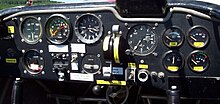
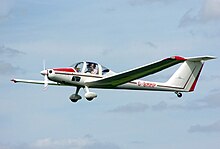
Touring motor glider ( English Touring Motor Glider , TMG ) describes a certain class of motor gliders with a fixed, non-retractable engine and a non-retractable propeller. According to the flight manual, a TMG must be able to take off and climb on its own. They are mainly used in powered flight for travel and training flights and mostly do not have the tandem seating arrangement typical for gliders. Some touring motor gliders can be used to perform aircraft tow launches . The maximum take-off weight is limited to 850 kg. Motor yachtsmen are also not allowed to have more than two seats. The most common type in Germany is the SF 25 "Falke" in different variants.
When the engine is switched off, the gliding properties are significantly better than those of powered aircraft, since the wing is designed for gliding and the propeller can usually be brought into a low-drag gliding position. For example, the HK 36 “Super-Dimona” from Diamond Aircraft has a glide ratio of 1:28, powered aircraft are around 1:10. Nonetheless, touring motor gliders are less suitable for pure thermal gliding, as they have a higher inherent sinking rate than gliders and because of their higher dead weight they climb more poorly.
Gliding was never in the foreground for touring motor gliders: in the 70s and 80s they spread in large numbers, especially as inexpensive light aircraft , of which real sailing ability was not required. In addition, however, neatly sailing samples were produced in small numbers and with greater construction effort, such as the RF 5B "Sperber" from Sportavia-Pützer and the SF 28 "Tandemfalke" from Scheibe , their better aerodynamic quality also increasing performance in powered flight. Newer models such as the Dimona, but also older models such as the G 109 , for which a turbo engine with 130 HP is offered as an upgrade option, are in no way inferior to "real" powered aircraft in terms of their powered flight performance and can with ranges of partially over 1000 km can also be used for longer travel flights.
The Stemme S10 occupies an exceptional position among the touring motor gliders : With a glide ratio of 50, a cruising speed of approx. 220 km / h and a range of 1720 km with 120 liters of fuel, it is currently the touring motor glider with the best flight performance. This construction, which one does not look at the motor glider in gliding, has features that no other touring motor glider offers in combination: high-performance glider cell with 23 meters span and flaps, retractable landing gear, retractable propeller, 4-stroke aircraft engine for continuous operation.
Since the 1990s, more and more low-cost microlight aircraft have taken on the role of low-cost powered aircraft. Motor sailors still have the great advantage that holders of a glider pilot license do not have to acquire a separate license, but rather that they can be flown with a relatively easy-to-acquire extension to the glider license. In addition, many glider clubs use motor gliders for training, which is why the planes are available there.
Since the reorganization of pilot licenses through Regulation (EU) No. 1178/2011 (EU-FCL), the approval, training and licensing of pilots has been regulated by the European Union . The authorization for touring motor gliders can then be acquired either as a class rating for the light aircraft pilot license and private pilot license for airplanes or as an extension for the glider pilot license (SPL) or light aircraft pilot license for glider pilots (LAPL (S)).
Glider with auxiliary engine

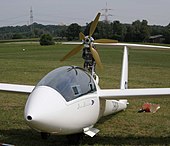
Gliders with auxiliary engines are mainly operated in glider flight . The auxiliary engine is usually a retractable engine that is only folded out for engine operation. It enables the onward flight if the flight cannot be continued in glider flight and partly self-launch . Because of the great air resistance of the unfolded engine, the best range is not achieved in horizontal cruise flight, but in so-called "sawtooth operation", ie you climb to an altitude of 1000 or 1500 meters with high engine power in a short time, fold the drive and glide as a fully aerodynamic one Glider a few kilometers to the next engine use.
The versions with the retractable engine correspond to a glider with the engine retracted . Current gliders are now almost all available in a motor glider version, which is associated with considerable surcharges. Nevertheless, today a large proportion of privately operated gliders are ordered motorized, as the usability increases enormously and, in the case of a self-starter, one is no longer necessarily dependent on group operation.
Motor gliders that cannot launch themselves are also called “turbos” in the gliding scene. This term is not to be understood technically, but colloquially: At the time when the first "turbos" were offered, the first road cars with turbochargers came onto the market. At that time, the word “turbo” established itself as a synonym for “super” or “a little more”. In this sense, the first gliders with auxiliary engines were also gliders with “a little more”. Other names for this motorization are "Flautenschieber" and "Heimkehrhilfe".
The engine of these aircraft is not suitable for starting, but is only an aid to onward flight. Many of them do not have a starter; their engine can be started by the airstream. A specific example of this category is the space plane SpaceShipOne that the Ansari X Prize won: it is accepted as a non-self-launching glider with auxiliary motor.
More recent developments also use small, powerful jet engines that are considerably lighter than conventional propulsion systems. Another current trend is the use of electric motors and high-performance batteries, such as As in the Antares 20E or the Schempp-Hirth Arcus E .
In Germany, gliders with auxiliary engines may be flown with a normal glider license after special instruction, and they may also be used in the air in engine mode. The entry "Start type Eigenstart" in the glider license is only required for takeoffs with a motor . The old, national class B private pilot's license (motor glider license), which was valid for all types of motor gliders, has not been issued in Germany since May 1, 2003 as part of the changeover to European flight licenses.
Ultralight "motor gliders"
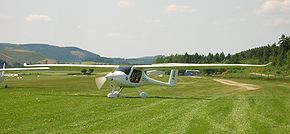
These include ultralight aircraft that can operate in powered flight and glider flight . Similar to motor sails, there are air sports equipment for ultralight flight that come very close in performance and appearance to classic touring motor gliders. B. Pipistrel Sinus and ultralight gliders with auxiliary engine, z. B. Banjo . For a few years now, motor gliders have also been sold as light air sports equipment , e.g. B. Gramex Song 120, which do not require a traffic permit. In terms of aviation law, these aircraft are not motor gliders, but air sports equipment.
Legal (foreign landing)
According to § 25 LuftVG in conjunction with § 18 LuftVO, only gliders, motor gliders (except touring motor gliders), hang-gliders and paragliders as well as manned free balloons are allowed to land outside the field without permission, provided that the place of landing cannot be determined in advance.
literature
- Ludwig Bölkow : A century of aircraft: history and technology of flight . VDI Verlag, Düsseldorf 1990, ISBN 3-642-95776-5 .
Web links
Individual evidence
- ↑ a b VO (EU) 1178/2011 FCL.010 Definitions
- ↑ §1 of the Aviation Act
- ↑ Appendix to the Aviation Ordinance, LFV
- ↑ § 4 Civil Aircraft and Aviation Equipment Ordinance 2010
- ^ A b c Ludwig Bölkow : A century of aircraft: history and technology of flying . VDI Verlag, Düsseldorf 1990, ISBN 3-642-95776-5 , p. 462 ff .
- ↑ Glyn Bradney: The SCUD gliders built by ABBOTT Baynes of Farnham. (PDF) In: glidingheritage.org.uk. Gliding Heritage Center, September 29, 2014, accessed April 8, 2020 .
- ^ Mario Michael von Loen: Annual report 1959 . Ed .: Akaflieg Karlsruhe - Technical University of Karlsruhe. No. VII , 1960, p. 11 ( akaflieg-karlsruhe.de [PDF; accessed April 9, 2020]).
- ↑ VO (EU) 1178/2011
- ↑ Patrick Holland-Moritz: Song is now flying in Germany . Ed .: aerokurier. November 13, 2013 ( aerokurier.de [accessed August 15, 2020]).


